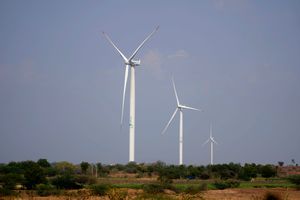The enablers of economic growth in one era are not necessarily applicable to another. The industrialisation of today’s developed world was built on the back of burning fossil fuels. Not just in power generation, but also in industrial and long-distance transport, hydrocarbons have fuelled growth in the past centuries.
Cumulatively, the developed countries of today have accounted for close to two-thirds of all emissions since 1750. In the 1.5° C warming scenario, only 14 per cent of the total carbon space remains, with 2,400 gigatonnes (Gt) of the available 2,800 Gt space already emitted. Since pre-industrial times, India has utilised 1.5 per cent of the total carbon space.
With the earth getting close to the 1.5° C warming target, countries today cannot grow through burning fossil fuels anymore. Growth cannot come at the expense of sustainability anymore. The challenge that lies in front of the developing nations is to decarbonise electricity generation, industrial operations and transport.
Recognising this challenge, India has emerged as a leader in the energy transition and the fight against climate change. First, much has been done to decarbonise electricity generation in India. The installed capacity of renewable energy now stands at 172 gigawatts (GW). We achieved the targets for 2030 set out in our first nationally determined contribution (NDC), nine years ahead of schedule. India’s updated NDC included a statement on propagating a healthy and sustainable lifestyle (LiFE), with the premise that the fight against climate change is a collective fight, rooted in individual and community behavioural change.
By 2030, half our electric installed capacity would be fed by renewables, and carbon intensity of our GDP would be reduced by 45 per cent over 2005 levels. The challenge with renewable energy is its inherent nature and its need to be bundled with storage to provide Round the Clock Renewable (RE-RTC) or On demand Carbon Free Energy (CFE) to the Indian grid. Energy storage is key for our energy transition into a low or zero carbon future. Energy storage will enable the grid to absorb more and more renewable energy and reduce overall carbon intensity of the Indian grid.
Power generation is not the only source of emissions. Industrial applications and transport are two other large producers of emissions. One solution to vehicular emissions is electric vehicles (EVs), which have gained substantial traction owing to government initiatives such as FAME (Faster Adoption and Manufacturing of Hybrid & Electric Vehicles). Together with production linked incentive (PLI) schemes for batteries and automobiles, the ecosystem for EVs in India needs a vigorous push. This would require:
♦ At least one million fast chargers in the country to adopt EVs in the next five years. Instead of importing, we need to push localisation content in manufacturing, with megawatt hour charging (Tesla has opened its charger’s IP) for buses and commercial vehicles.
♦ Advanced Chemistry Cell (ACC) battery storage is critical world over—the capacity is surpassing 500GW. Only 30GW has been allotted under PLI. This needs to be expanded and localisation should happen on a large scale. In its absence India will become the assembly house of finished products for cell manufacturing.
♦ Repurposing and recycling of ACC batteries:
Lithium-based batteries need a disposal policy. We need to repurpose and recycle them on giga scale.
Industrial emissions and long-distance transport are two areas where decarbonisation strategies need to be accelerated. So, too, shipping and aviation. These have been characterised as ‘hard-to-abate’ sectors. This is where green hydrogen (GH2) comes into the picture. It can play a crucial role in decarbonising these hard-to-abate sectors. Recognising the importance of GH2, the National Green Hydrogen Mission has been announced. It aims to make India a global hub for production and export of GH2. Green hydrogen is produced by using renewable energy to crack water through electrolysers.
National competitiveness now will not just be a function of labour, capital and technology, but also a function of sustainability. Export markets will increasingly be conscious of carbon footprints. India must become the first country to industrialise without the need to carbonise.
The author is G20 Sherpa, government of India, and former CEO, NITI Aayog. All views expressed are personal.


